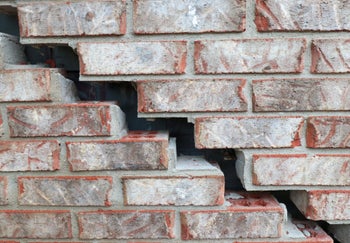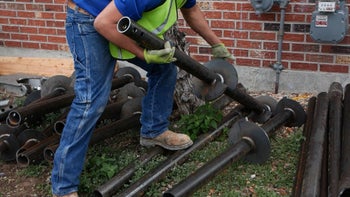Should I Be Worried About Cracks in Brick?
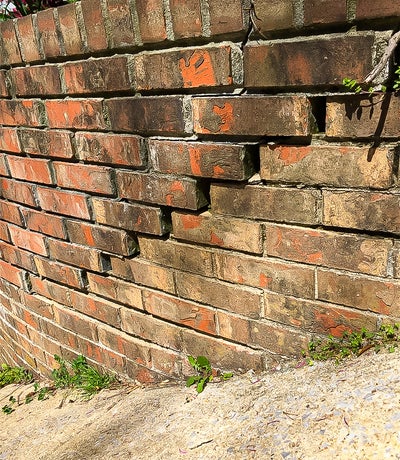
Throughout your time as a homeowner, you’re likely going to encounter damage like cracks. This includes cracks in brick walls.
Brick is popular for its durability and visual appeal. However, damage is inevitable over time. While it’s important not to panic, you shouldn’t ignore cracks in brick walls, either.
This article explains everything you need to know about cracks in brick, including when you should be concerned about their presence.
The key takeaway: brick cracks can signify major structural problems, so vigilance and prompt professional foundation repair are key.
4 Types of Cracks in Brick Walls
While bricks have long been favored building materials for homes and other structures because of their strength and aesthetics, even the sturdiest brick walls can fall victim to damage like cracks. These cracks can develop in all shapes and sizes. Here are a few of the most common types of cracks you’ll notice in brick walls:
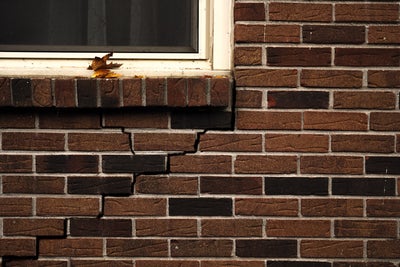
1. Stair-Step Cracks
- Appearance: These cracks form a pattern resembling stairs, zigzagging along the mortar joints between bricks.
- Causes: Typically, this indicates that the ground beneath the house is moving or shifting.
- Concern Level: Since stair-step cracks could point to foundational issues, having them evaluated by a foundation specialist is crucial.

2. Horizontal Cracks
- Appearance: Straight lines that extend horizontally across the wall from one end to the other.
- Causes: Often caused by pressure from the surrounding soil (hydrostatic pressure), which may occur due to extreme moisture variations.
- Concern Level: Horizontal cracks suggest excessive lateral pressure on the wall, which can lead to significant structural damage, including wall collapse.

3. Vertical Cracks
- Appearance: Long, straight vertical lines running up and down the wall.
- Causes: Commonly associated with the natural settling process of the house, especially in newer constructions.
- Concern Level: If these cracks continue to grow, it’s important to get them inspected to ensure there are no severe underlying issues.
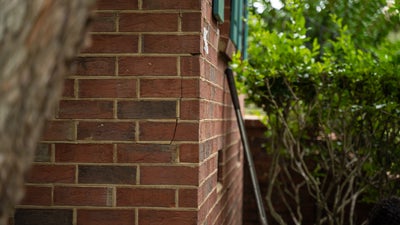
4. Hairline Cracks
- Appearance: Very fine lines that are difficult to notice with the naked eye unless closely inspected.
- Causes: These cracks may occur due to minor settling of the house, changes in the weather, or aging of the bricks.
- Concern Level: If these cracks widen or multiply, it’s advisable to consult a professional for an assessment.
Understanding the implications of these cracks is key to maintaining the integrity of your home. If you notice worsening conditions or have concerns about your home’s structural health, seeking prompt advice from a professional like Ohio Basement Authority is always the best course of action.
5 Common Sources of Brick Wall Cracks
We just gave you a high-level glimpse as to why these types of cracks happen, but let’s dig a little deeper. It’ll help you understand how these cracks formed in the first place and tap into our team’s knowledge base of determining how to address the associated damage.
Several factors contribute to underlying foundation issues like settlement and sinking, as well as subsequent brick cracks, including:
- Soil Type and Movement: Soils rich in clay expand when moist and contract when dry, causing significant vertical shifting in the foundation that destabilizes brick walls. This continuous movement may cause the foundation to sink, separate bricks and mortar, and lead to stair-step cracks.
- Extreme Weather: Severe weather conditions can also strain foundations. Intense rain can saturate the ground, droughts can severely dry it, and freezing temperatures can cause ground moisture to expand—all exerting undue pressure on the foundation.
- Improper Drainage: Inadequate drainage can lead to water pooling around the foundation, softening the soil and making it unstable, which may result in foundation shifts or sinking.
- Water Pressure: High moisture levels in the soil can generate hydrostatic pressure against foundation walls, especially with poor drainage, often causing horizontal cracks and bowing as the walls try to hold up under the stress.
- Tree Roots: Trees located too close to a foundation can cause issues as roots extract moisture from the soil, weakening it and sometimes leading to settlement. Additionally, roots can physically invade the foundation, resulting in cracks and structural compromises.
Recognizing these contributing factors early on can help you identify potential problems before they escalate.
More Common Foundation Signs
Now that you know where and how cracks in brick begin, it’s equally important to recognize other symptoms. Brick cracks rarely show up alone. They often accompany or co-occur with other signs of foundation damage, including:
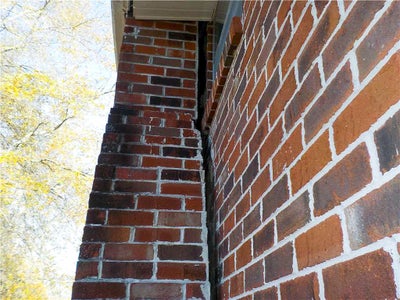
These are also serious issues requiring prompt attention, but they are not beyond repair if caught early enough.
What’s the Best Way to Fix Cracks in Brick?
While brick cracks are concerning, we encourage you to resist the urge to fill and repair them yourself. This is merely a cosmetic approach that doesn’t address the cause of the problem.
Trust local foundation repair professionals like Ohio Basement Authority to tackle foundation settlement or hydrostatic pressure with the right tools. The solutions we may recommend for your cracking brick home include:
Wall Repair Systems
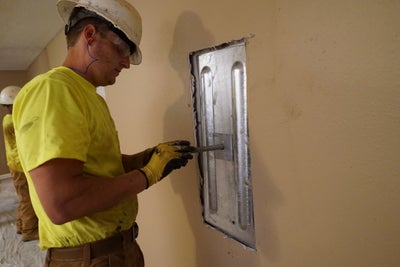
For walls compromised by hydrostatic pressure, we employ specialized repair strategies. Our wall repair solutions are designed to permanently stabilize bowing or shearing basement walls, halt further movement, and potentially mend existing cracks.
Our wall anchor and channel anchor systems are comprised of earth anchors secured in stable soil away from the foundation, interior wall plates, and metal rods that connect the two. When tightened, the rods counteract the surrounding soil’s pressure and can pull the compromised basement walls back into alignment.
Similarly, our wall beams are attached to basement walls and securely anchored to both the basement floor and floor joists above. This creates a rigid structure that keeps the walls straight, minimizes the severity of existing brick cracks, and prevents future structural issues.
Foundation Piers

Foundation piers are the most effective method for addressing foundation settlement issues. At Ohio Basement Authority, we provide three types of piers: helical, push, and slab. While each type varies in design and installation, all work to permanently stabilize your settling foundation by anchoring into the stable soil or bedrock beneath your home.
These systems involve metal rods that connect to the foundation and extend deep into the ground. By doing so, they stabilize the foundation, preventing any further movement and effectively redistributing the weight of your home to prevent cracks. Additionally, they can potentially lift your home back to its original level, which may help seal any existing cracks in the brickwork.
FAQs
Look in areas like brick veneers, basement walls, and chimneys. Cracks often start small in places you might overlook. Call Ohio Basement Authority for a free inspection and repair estimate and to learn more.
Horizontal cracks often indicate bowing walls resulting from excess soil pressure and/or foundation settlement. This signifies structural instability requiring prompt repair. Contact Ohio Basement Authority for a free inspection right away.
Simply re-mortaring won’t prevent further cracking. Address the underlying foundation issues first, then proceed with re-grouting the bricks. Contact Ohio Basement Authority for a free foundation inspection and repair estimate.
Contact Us Today for Your Foundation Needs

If you notice cracks in your brick walls and are concerned about the underlying issues, don’t hesitate to contact Ohio Basement Authority. Equipped with industry-leading solutions and a dedicated team of professionals, homeowners across Ohio trust us to enhance their home safety and foundation integrity.
We are committed to delivering top-notch service and ensuring the structural safety of your home. Don’t let brick wall cracks threaten your home’s stability—schedule a free inspection with Ohio Basement Authority today!
Related Resources
Publish Date:
Last Modified Date:

Our Locations
429 Portage Blvd
Kent, OH 44240
1270 Hillsmith Dr.
Cincinnati, OH 45215
7950 Bavaria Rd.
Twinsburg, OH 44087
2421 McGaw Rd.
Obetz, OH 43207
70 Birch Alley, Suite 240
Beavercreek, OH, 45440
5650 Blazer Memorial Pkwy, #124
Dublin, OH 43017


